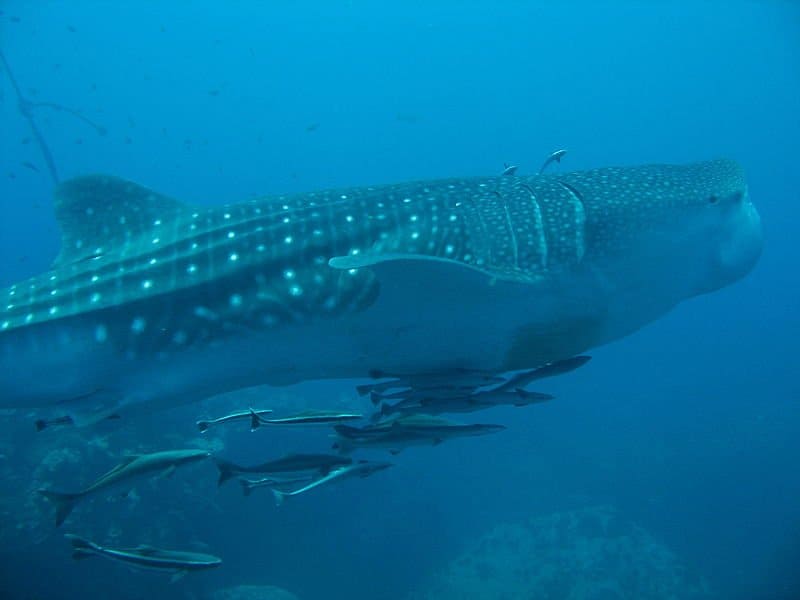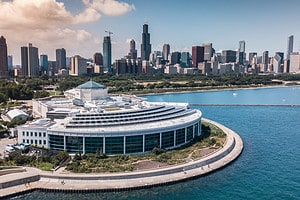Whale sharks may be the most interesting fish on the planet, not to mention the largest. These spotted giants can be found in tropical and temperate oceans all over the world, although they are considered to be endangered. While it’s somewhat tough to see a whale shark in its natural habitat, it can be seen in a few aquariums around the world.
For many, aquariums are the best (and only) plausible place to glimpse the world’s largest fish species. Seeing these giants in the wild is possible, but it’s difficult due to their limited population and avoidance of shallow water. Ecotourism has gained popularity in places like Mexico recently (tourists can pay to swim with whale sharks in the wild), but it’s only possible because of its proximity to natural feeding grounds.
4 Aquariums with Whale Sharks
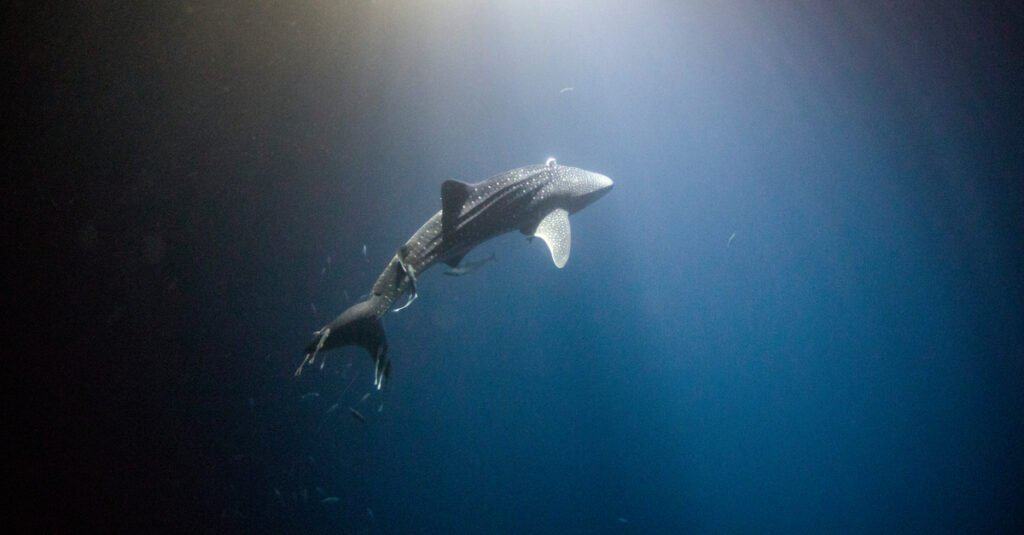
Whale sharks need large aquariums to survive for any amount of time in captivity.
©Lindsey Lu/Shutterstock.com
Since whale sharks are so large, only a few aquariums in the world can properly house them. Let’s take a look at five aquariums with whale sharks and learn a little bit about the fish (and the aquarium) as we go. If you happen to find yourself near one of these aquariums, you’ll now know you can stop by and see these truly majestic animals. Let’s start.
Georgia Aquarium

The Georgia Aquarium houses the only whale sharks in the West.
©weera bunnak/Shutterstock.com
The Georgia Aquarium is a scientific institution that allows public viewing of many of its animals. Located in Atlanta, Georgia, they maintain 11 million gallons of water and have exhibits and programs that guests can view up close. The Georgia Aquarium is a leader in the research space and animal care.
It was the largest aquarium in the world when it opened in 2005. However, in 2012, it was surpassed by the S.E.A. Aquarium in Singapore. The Atlanta Georgia Aquarium, however, remains the largest aquarium located in Atlanta, Georgia, and the United States. It is also the third largest in the entire world. In fact, it takes about 3 or 4 hours to view everything within the entire aquarium.
The Atlanta Georgia Aquarium’s official TikTok account has been the source of some amazing footage of beluga whales and educational content. However, they are finally answering one of their audience’s most asked questions: How do you get whale sharks into the aquarium?
To answer that question, their whale sharks came from Taiwan in 2007 where they were sadly going to be sold at a fish market. They were transported on a private plane in a specially-made container. Through their transport, there were many people around them the entire time to make sure they were safe and secure. They were then escorted from the airport to the aquarium.
Check out this video all about it:
Georgia Aquarium’s main focus is to combine field research with site-controlled research to allow for in-depth understanding and care of the world’s sea creatures. Furthermore, the Georgia Aquarium is the only Western aquarium to house whale sharks.
One of the best features of the Atlanta, Georgia Aquarium is the Ocean Voyager tank. This tank is one of the largest in the world and holds 6.3 million gallons of seawater. With a space so large, it’s no wonder they can keep the world’s largest fish. Inside the tank are fish, sharks, and of course, whale sharks. Housed within is not just a single whale shark, but four. As you sit staring at the massive glass viewing area, you can see four separate whale sharks in a single tank.
Additionally, you don’t have to visit the aquarium to see them either. They also offer a free live stream on their website. Anyone wanting to spot one from home, can!
Churaumi Aquarium
The Churaumi Aquarium is located in Okinawa, Japan, and is designed to display the incredible creatures near Okinawa. Aside from just fish, the aquarium displays the history and cultural importance of various ocean life. The tanks open for display at the Churaumi Aquarium are the Coral Sea Tank, the Kuroshio Sea Tank, and the Deep Sea Tank.
If you are in Okinawa and want to see whale sharks, the best place to look is going to be the Kuroshio Sea Tank. The program houses a few captive-bred whale sharks that are displayed through thick acrylic. Additionally, Churaumi Aquarium is at the forefront of whale shark breeding efforts, and its program is focused on that goal. Since the program’s inception, they have raised multiple whale sharks to maturity and used their specimens to learn more about the mysterious fish.
Kaiyukan Aquarium

The Kaiyukan Aquarium displays whale sharks in their Pacific Ocean display.
The Kaiyukan Aquarium is a beautifully designed aquarium located near Osaka Bay, Japan. The Japanese aquarium is designed around the Ring of Fire, a volcanically active region across the Pacific tectonic plate. The aquarium has 15 tanks designed after various regions found within the Pacific rim. The aquarium’s “centerpiece” is its largest tank, the Pacific Ocean. The exhibit is 9 meters deep and holds 5,400 tons of water, making it the only home for a whale shark in the aquarium.
The Kaiyukan Aquarium pioneers whale shark research. Their Pacific Ocean tank holds whale sharks that can be viewed by anyone nearby. As their largest tank, the Pacific Ocean is 9 meters by 34 meters, allowing the sharks to swim around with relative ease. Aside from their research within the aquarium, the research team also tags and studies wild specimens. In fact, they were the ones to discover that whale sharks can dive to depths of 1,300 meters.
Ioworld Kagoshima Aquarium
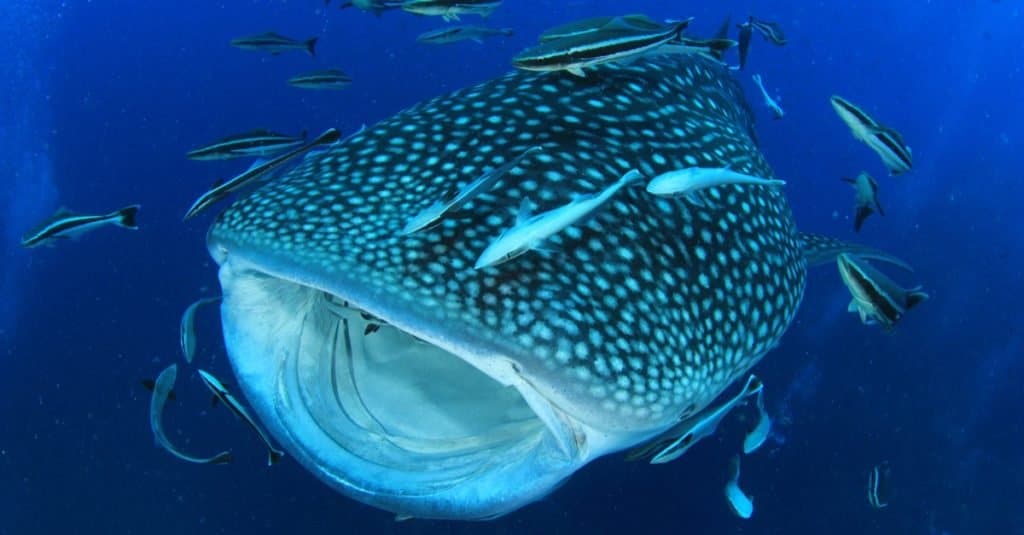
Whale sharks are captured, raised, and then released when they reach 5.5 meters at the Kagoshima Aquarium.
©Rich Carey/Shutterstock.com
Ioworld Kagoshima Aquarium is located in Kagoshima City, Kagoshima Prefecture, Japan. The “io” in “ioworld” is actually a local dialect that means “fish.” The aquarium is known for its whale sharks and dolphin shows, with their dolphins living in the nearby Kinko Bay. The aquarium is a bit smaller than the others on the list, and their shows are totally in Japanese, making for more manageable crowds.
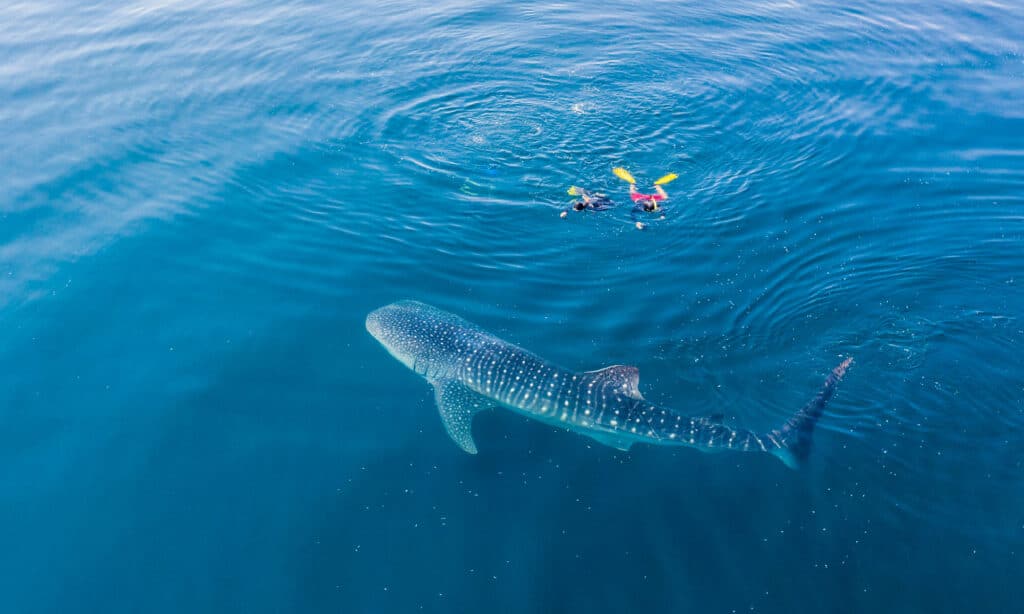
Ioworld Kagoshima Aquarium employs a unique catch-and-release system – capturing young whale sharks in nearby seas and releasing them back into the ocean after they reach a size of 5.5 meters.
©iStock.com/Velvetfish
One of the most interesting practices that Ioworld utilizes is the capture and release of its whale sharks. Whale sharks are notorious for dying in captivity. To work around this, Ioworld has a special practice in place. They capture small (young) whale sharks in their nearby ocean and use them in their tanks. When they reach a length of 5.5 meters, they are then released back into the ocean where they came from.
Summary of Which Aquariums Keep Whale Sharks
In case you want to plan a five-stop visit to the world’s captive Whale sharks, here’s where you can find them in a condensed version.
| Name | Location |
|---|---|
| Ioworld Kagoshima Aquarium | Kagoshima City, Japan |
| Kaiyukan Aquarium | Osaka Bay, Japan |
| Churaumi Aquarium | Okinawa, Japan |
| Georgia Aquarium | Georgia, USA |
Why Is the Whale Shark Endangered?
Whale shark numbers have been decreasing to the point that the IUCN declared them endangered in 2016. There has been as much as a 75% decline in their population in certain parts of the Pacific.
Whale sharks have natural predators, despite their size, such as great white sharks, tiger sharks, and orcas. They prey upon the younger, smaller sharks, of course, because the adult whale sharks are too big to challenge. This natural food chain interaction, however, is not responsible for the decline.
A bigger threat is humans who accidentally catch the whale sharks in fishing nets and then might not be able to save them. Intentional killing happens when hunters from India, the Philippines, and China catch them for food, oil, and their fins (used for supposed medicinal qualities) . Many other countries, though, have banner or regulated whale shark hunting.
Even more significant damage is done to the whale shark population by other human-caused problems: habitat loss, overfishing the whale shark’s food supply, increased boat traffic that can hit a whale shark, and coastal development. Add two types of pollution to this degradation: noise pollution and chemical pollution such as waste waters and oil spills flowing into the oceans.
It is thought that the most significant threat to whale sharks is habitat loss or degradation in the form of overfishing of reef fish, coastal development, land-based pollution, increased boat traffic and noise pollution. Fishing for meat and fins, harassment and boat strikes also pose serious threats to whale sharks.
The photo featured at the top of this post is © Fata Morgana by Andrew Marriott/Shutterstock.com
Thank you for reading! Have some feedback for us? Contact the AZ Animals editorial team.



